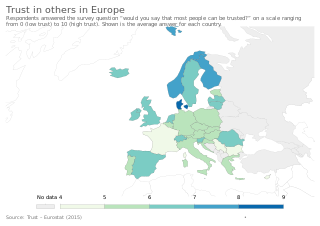Related Research Articles

Emotions are mental states brought on by neurophysiological changes, variously associated with thoughts, feelings, behavioural responses, and a degree of pleasure or displeasure. There is currently no scientific consensus on a definition. Emotions are often intertwined with mood, temperament, personality, disposition, or creativity.

In sociology, socialization is the process of internalizing the norms and ideologies of society. Socialization encompasses both learning and teaching and is thus "the means by which social and cultural continuity are attained".

Symbolic interactionism is a sociological theory that develops from practical considerations and alludes to particular effects of communication and interaction in people to make images and normal implications, for deduction and correspondence with others. According to Macionis, symbolic interactionism is "a framework for building theory that sees society as the product of everyday interactions of individuals". In other words, it is a frame of reference to better understand how individuals interact with one another to create symbolic worlds, and in return, how these worlds shape individual behaviors. It is a framework that helps understand how society is preserved and created through repeated interactions between individuals. The interpretation process that occurs between interactions helps create and recreate meaning. It is the shared understanding and interpretations of meaning that affect the interaction between individuals. Individuals act on the premise of a shared understanding of meaning within their social context. Thus, interaction and behavior is framed through the shared meaning that objects and concepts have attached to them. From this view, people live in both natural and symbolic environments.

In micro-sociology, interactionism is a theoretical perspective that sees social behavior as an interactive product of the individual and the situation. In other words, it derives social processes from social interaction, whereby subjectively held meanings are integral to explaining or understanding social behavior.
Impression management is a conscious or subconscious process in which people attempt to influence the perceptions of other people about a person, object or event by regulating and controlling information in social interaction. It was first conceptualized by Erving Goffman in 1959 in The Presentation of Self in Everyday Life, and then was expanded upon in 1967.

Social exchange theory is a sociological and psychological theory that studies the social behavior in the interaction of two parties that implement a cost-benefit analysis to determine risks and benefits. The theory also involves economic relationships—the cost-benefit analysis occurs when each party has goods that the other parties value. Social exchange theory suggests that these calculations occur in romantic relationships, friendships, professional relationships, and ephemeral relationships as simple as exchanging words with a customer at the cash register. Social exchange theory says that if the costs of the relationship are higher than the rewards, such as if a lot of effort or money were put into a relationship and not reciprocated, then the relationship may be terminated or abandoned.

Trust is the willingness of one party to become vulnerable to another party on the presumption that the trustee will act in ways that benefit the trustor. In addition, the trustor does not have control over the actions of the trustee. Scholars distinguish between generalized trust, which is the extension of trust to a relatively large circle of unfamiliar others, and particularized trust, which is contingent on a specific situation or a specific relationship.
Herbert George Blumer was an American sociologist whose main scholarly interests were symbolic interactionism and methods of social research. Believing that individuals create social reality through collective and individual action, he was an avid interpreter and proponent of George Herbert Mead's social psychology, which he labelled symbolic interactionism. Blumer elaborated and developed this line of thought in a series of articles, many of which were brought together in the book Symbolic Interactionism. An ongoing theme throughout his work, he argued that the creation of social reality is a continuous process. Blumer was also a vociferous critic of positivistic methodological ideas in sociology.
In sociology, social action, also known as Weberian social action, is an act which takes into account the actions and reactions of individuals. According to Max Weber, "Action is "social" insofar as its subjective meaning takes account of the behavior of others and is thereby oriented in its course."

Social behavior is behavior among two or more organisms within the same species, and encompasses any behavior in which one member affects the other. This is due to an interaction among those members. Social behavior can be seen as similar to an exchange of goods, with the expectation that when you give, you will receive the same. This behavior can be affected by both the qualities of the individual and the environmental (situational) factors. Therefore, social behavior arises as a result of an interaction between the two—the organism and its environment. This means that, in regards to humans, social behavior can be determined by both the individual characteristics of the person, and the situation they are in.
The Thomas theorem is a theory of sociology which was formulated in 1928 by William Isaac Thomas and Dorothy Swaine Thomas:
If men define situations as real, they are real in their consequences.

Mathematical sociology or the sociology of mathematics is an interdisciplinary field of research concerned both with the use of mathematics within sociological research as well as research into the relationships that exist between maths and society.

In sociology, social psychology studies the relationship between the individual and society. Although studying many of the same substantive topics as its counterpart in the field of psychology, sociological social psychology places relatively more emphasis on the influence of social structure and culture on individual outcomes, such as personality, behavior, and one's position in social hierarchies. Researchers broadly focus on higher levels of analysis, directing attention mainly to groups and the arrangement of relationships among people. This subfield of sociology is broadly recognized as having three major perspectives: Symbolic interactionism, social structure and personality, and structural social psychology.
Social perception is the study of how people form impressions of and make inferences about other people as sovereign personalities. Social perception refers to identifying and utilizing social cues to make judgments about social roles, rules, relationships, context, or the characteristics of others. This domain also includes social knowledge, which refers to one's knowledge of social roles, norms, and schemas surrounding social situations and interactions. People learn about others' feelings and emotions by picking up information they gather from physical appearance, verbal, and nonverbal communication. Facial expressions, tone of voice, hand gestures, and body position or movement are a few examples of ways people communicate without words. A real-world example of social perception is understanding that others disagree with what one said when one sees them roll their eyes. There are four main components of social perception: observation, attribution, integration, and confirmation.
Identity control theory is a theory in sociology concerned with the development of personal identity. Created by Peter Burke, it focuses on the nature of peoples' identities and the relationship between their identities and their behavior within the realm of their social structure. The identities of the individual are rooted in their social structure. Identity Control Theory was created based on traditional symbolic interaction views where people choose their own behaviors and how their behaviors correspond to the meanings of their identity. One of the main aspects ICT deals with is how individuals view their own identities and respond to the reactions to their identities of those around them. When an individual is acting according to the identity control theory they reflect on the identity they display and how others approve or disapprove of their identity. If the individual does not like the responses of others they will look at how they can change their views of their identity or their identity towards themselves to produce a positive outcome. One of the main benefits of this theory is how negative feelings can be prevented by individuals and by those around them. The people around someone who is displaying a certain identity have the ability to be more sensitive and prevent negative feelings if they understand identity control theory because they know what will bring out a negative response. On the other hand, the individual can prevent negative feelings that coincide with the teachings of identity control theory if they understand these teachings and can apply them to their own lives.

The sociology of emotion applies sociological theorems and techniques to the study of human emotions. As sociology emerged primarily as a reaction to the negative effects of modernity, many normative theories deal in some sense with emotion without forming a part of any specific subdiscipline: Karl Marx described capitalism as detrimental to personal 'species-being', Georg Simmel wrote of the deindividualizing tendencies of 'the metropolis', and Max Weber's work dealt with the rationalizing effect of modernity in general.
Impression formation in social psychology refers to the processes by which different pieces of knowledge about another are combined into a global or summary impression. Social psychologist Solomon Asch is credited with the seminal research on impression formation and conducted research on how individuals integrate information about personality traits. Two major theories have been proposed to explain how this process of integration takes place. The Gestalt approach views the formation of a general impression as the sum of several interrelated impressions. As an individual seeks to form a coherent and meaningful impression of another individual, previous impressions significantly influence the interpretation of subsequent information. In contrast to the Gestalt approach, the cognitive algebra approach asserts that individuals' experiences are combined with previous evaluations to form a constantly changing impression of a person. A related area to impression formation is the study of person perception, making dispositional attributions, and then adjusting those inferences based on the information available.
David Reuben Jerome Heise was a social psychologist who originated the idea that affectual processes control interpersonal behavior. He contributed to both quantitative and qualitative methodology in sociology. He retired from undergraduate teaching in 2002, but continued research and graduate student consulting as Rudy Professor of Sociology Emeritus at Indiana University. He is most well known for his work on affect control theory. Heise died on September 28, 2021, after a brief illness.
A vignette in psychological and sociological experiments presents a hypothetical situation, to which research participants respond thereby revealing their perceptions, values, social norms or impressions of events.

Interpersonal communication is an exchange of information between two or more people. It is also an area of research that seeks to understand how humans use verbal and nonverbal cues to accomplish a number of personal and relational goals.
References
- ↑ Osgood et al. (1975).
- ↑ Osgood et al. (1975).
- ↑ Heise (2001) provides a detailed description of this work.
- ↑ Gollob (1968); Gollob and Rossman (1973).
- ↑ See Heise (1979), Ch. 2; Smith-Lovin & Heise (1988); Britt & Heise (1992); Smith et al. (1994); Smith & Francis (2005); and Schröder (2011).
- ↑ Smith-Lovin & Heise (1988).
- ↑ Heise & MacKinnon (1987).
- ↑ Heise (2007), pp. 60-62.
- ↑ Heise (2007), Part II.
- ↑ Heise (2007), Ch. 5.
- ↑ Heise (2007), Chs. 10, 16.
- ↑ Heise (1979), Ch. 5; MacKinnon (1994), Ch. 6; Heise (2007), Ch. 7.
- ↑ Heise (1979), pp. 118–124; Heise (2007), pp. 53–55.
- ↑ Schneider and Heise (1995).
- ↑ Averett and Heise (1987); Heise and Weir (1999); Heise (2007), Chs. 8, 14.
- ↑ Averett & Heise (1988); Heise & Thomas (1989); Schröder (2011); Smith et al. (2001).
- ↑ Heise (1997).
- ↑ Heise (2004).
- ↑ Pavloski (1989).
- ↑ Goldstein (1989).
- ↑ Heise (2007), p. 62.
- ↑ Nelson (2006).
- ↑ Heise (1979), pp. 86–89, 127–132; MacKinnon (1994), Ch. 8; Heise (2007), Chs. 9, 13.
- ↑ Heise (2006).
- ↑ (Hourigan 2019)
- ↑ (Heise 1978)
- ↑ Heise (2007), Chapter 19.
- ↑ Hoey, Alhothali, and Schroeder (2013).